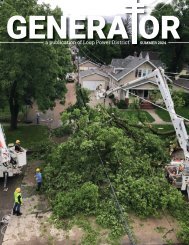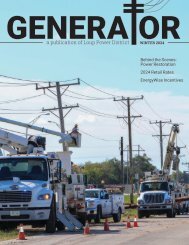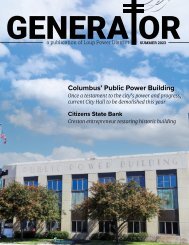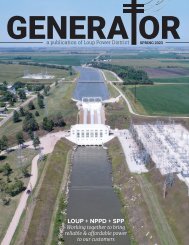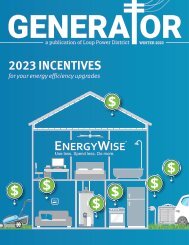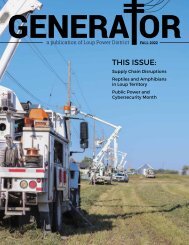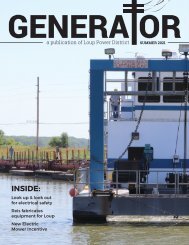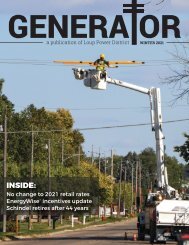Loup Generator — Winter 2022
Learn more about the invasive species in Nebraska and what you can do if you spot them. The 2022 list of financial incentives available to customers who make energy-efficient upgrades. Also in this issue, Mini-Splits 101: an introduction for homeowners.
Learn more about the invasive species in Nebraska and what you can do if you spot them. The 2022 list of financial incentives available to customers who make energy-efficient upgrades. Also in this issue, Mini-Splits 101: an introduction for homeowners.
You also want an ePaper? Increase the reach of your titles
YUMPU automatically turns print PDFs into web optimized ePapers that Google loves.
BOARD OF DIRECTORS<br />
Ross Knott<br />
Chairman<br />
Alan Drozd<br />
First Vice Chairman<br />
Steve Heesacker<br />
Second Vice Chairman<br />
Robert Cerv<br />
Secretary<br />
Dick Tooley<br />
Treasurer<br />
Rich Aerni<br />
Jim Donoghue<br />
Mike Fleming<br />
Chris Langemeier<br />
Larry Zach<br />
HOW DO WE SET<br />
ELECTRICITY RATES?<br />
<strong>Loup</strong> Power District identifies electricity rates based on cost of service<br />
while keeping our customers and our communities front and center. As a<br />
not-for-profit company, <strong>Loup</strong> does not answer to remote shareholders and<br />
is not driven by a profit motive. Revenues are invested right back into the<br />
company and communities.<br />
EXECUTIVE STAFF<br />
Neal Suess<br />
President/CEO<br />
Walt Williams<br />
Vice President,<br />
Accounting & Finance/CFO<br />
Todd Duren<br />
Vice President,<br />
Corporate Services<br />
Korey Hobza<br />
Vice President, Engineering<br />
Dan Hellbusch<br />
Vice President, Operations<br />
The <strong>Loup</strong> <strong>Generator</strong> is<br />
published quarterly<br />
as a service for <strong>Loup</strong><br />
employees, families,<br />
friends, and associates.<br />
For feedback, story ideas<br />
and submissions, contact:<br />
Stacy Wemhoff<br />
Communications Coordinator<br />
402-562-5711<br />
swemhoff@loup.com<br />
ADD UP ALL THE COSTS. <strong>Loup</strong> conducts a cost-of-service study to<br />
determine the revenue requirement <strong>—</strong> how much revenue is required<br />
to maintain financial stability. The costs are separated into three areas:<br />
power supply and transmission, distribution, and customers.<br />
DIVIDE REVENUE REQUIREMENTS by customer class <strong>—</strong> commercial,<br />
industrial, residential. The cost-of-service study identifies how and when<br />
each class uses energy, and how the utility incurs costs from each class.<br />
The study identifies the amount to recover through customer, demand,<br />
and energy charges for each customer class, and how costs vary by time of<br />
day or season. This amount is then compared with the rates for each class.<br />
FACTOR a rate adjustment strategy into a financial plan. The plan takes input<br />
from management and the Board of Directors and lays out a strategy for<br />
how rates should be implemented in the future. The plan ensures adequate<br />
revenues are recovered for each class of customer and explains how each<br />
rate component (customer, energy, demand) should vary over time.<br />
BALANCE the recommended rates with the governing body’s input and<br />
community objectives. <strong>Loup</strong>’s managers present the rate study to the Board<br />
of Directors. The Board decides whether the proposed rate structure meets<br />
the needs of the community and the utility’s revenue requirements.<br />
FINAL RATE. The newly set rates go into effect on<br />
customers’ monthly bills. <strong>Loup</strong>’s residential rates have<br />
not changed since 2018.<br />
2 | GENERATOR<br />
COVER PHOTO: Musk thistles. Photo by Nebraskaland Magazine/Nebraska Game and Parks Commission.



